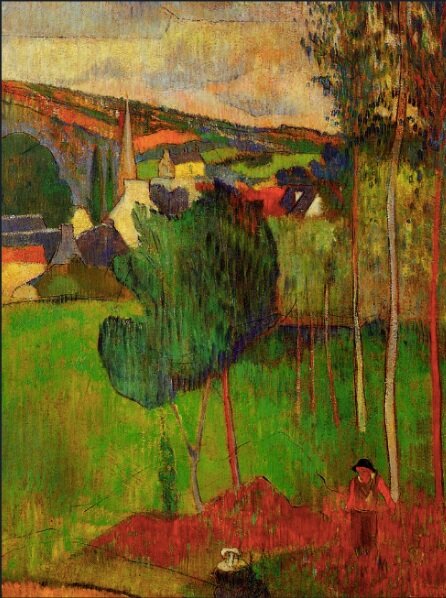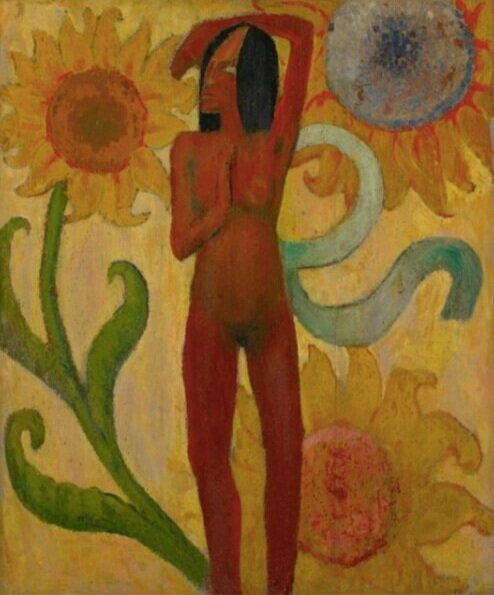Paintings by Paul Gauguin at the De Zayas Gallery
gUEST POST BY MARIANA AGUIRRE, Instituto de Investigaciones Estéticas (UNAM), Mexico City. (BIO BELOW.)
One hundred years ago today… Thanks to Mexican cartoonist and cultural promoter Marius de Zayas (1880-1961), New Yorkers could see French painter Paul Gauguin's work up close.
Marius de Zayas, 1925. Photo by Alfred Steiglitz. National Gallery of Art.
De Zayas, the son of a rich writer and lawyer from Veracruz, moved to New York in 1907. He collaborated with Alfred Stieglitz and was the first to exhibit African art alongside modernist works in the United States. Although his interest in Cubism was not immediate, the artist soon began to promote this style and other strands of French modernism in his adopted city. From 1919 to 1921, de Zayas organized several exhibits featuring European and American modernists as well as non-Western art at the De Zayas gallery 549 5th Avenue, between 46th and 47th Streets.
Title page and list of works, Paul Gaughin. De Zayas Gallery, April 5, 1920. Abebooks.com.
Between April 5 and April 17, 1920, the De Zayas Gallery displayed several works by Paul Gauguin, whose move to Tahiti sparked French artists’ interest in ‘primitive’ art. The exhibit featured thirty-two works, which the organizer had borrowed thanks to the contacts developed during his trips to Paris. This built upon the first two exhibits at the gallery, which featured Chinese and African art, respectively. These exhibits were later complemented by an exhibit of French, American, Asian, and African art in September-December 1920 and by an exhibit of Chinese paintings in February 1921.
Paul Gauguin, View of Pont Aven from Lezaven, 1888. Wikicommons.
The exhibit of Gauguin’s works was the artist’s first solo show in the United States, and was also tied to the rise of private collectors’ interest in his works. This was likely also bolstered by the success of W. Somerset Maugham’s novel The Moon and Sixpence, based on the artist’s life, in 1919. It is likely that the wider public had an interest in Gauguin’s Tahitian pictures, since critics from American Art News and the New York Herald warned readers that the works on view predated the artist’s Tahitian phase. Other critics observed that de Zayas was merely taking advantage of the rising market for Gauguin’s works in the United States. According to de Zayas, however, he had intended to exhibit works by Gauguin and Van Gogh in his first gallery as early as 1915.
Paul Gauguin, Bonjour Monsieur Gauguin. Courtesy Hammer Museum, UCLA. Wikicommons.
Susan Alyson Stein has traced several of the works on view at De Zayas’ gallery, most of which were first exhibited publicly at the Galerie Barbazanges in Paris. These include Self-Portrait with Halo, Portrait of Meyer de Haan, Caribbean Woman, Still Life “Ripipoint,” Bonjour Monsieur Gauguin, and View of Pont-Aven near Lézavan. Although only Caribbean Woman seems to suggest the artist’s eventual shift to an exotic primitivism, several of these works incorporated elements Gauguin and his contemporaries took from Japanese prints. Moreover, most of the works on view were created during his stay in Brittany, where his depictions of this region’s natural landscapes and peasant population anticipated his escape to Tahiti. Specifically, Caribbean Woman, from 1889, appears to have been inspired by a photograph of a Javanase temple that the artist had seen the previous year at the Exposition Universelle in Paris. This painting was sold by de Zayas to John Quinn and was exhibited at the Metropolitan Museum of Art in 1921 alongside other Impressionist and Post-Impressionist works.
Marius de Zayas Gallery, New York. Exhibition of Paintings by Paul Gauguin, 1920, no. 2 (titled Caribbean Woman and Sunflowers). Sothebys.
De Zayas’ exhibit of Gauguin’s work was part of an ongoing project to introduce the history of French modernism to New York audiences. The De Zayas gallery also held solo exhibits of American artists: Arthur B. Davies, Walt Kuhn, John Covert, and Charles Sheeler. Unfortunately, de Zayas’ memoirs do not discuss his activities related to this gallery. This is likely due to the fact that de Zayas had difficulty selling the works he exhibited and was unable to engage the public, as he wrote to Stieglitz in 1922. After the gallery closed, de Zayas moved to Paris, and despite his disillusionment with the American public, he continued to organize exhibitions in New York during the twenties.
Paul Gauguin, Self-Portrait With Halo and Snake, 1889. Wikicommons.
While de Zayas remains a key figure for understanding mainstream American modernism and the reception of European modernism, his interest in African art and modernist primitivism was also key for the development of the Harlem Renaissance and African-American art in general. For instance, Alain Locke’s writings on African art from 1924 and 1925 were indebted to de Zayas’ exhibits and writings. Much like the Mexican writer, Locke emphasized the important influence African art had on European modernists, and he suggested that African-American artists study African sculpture so as to avoid imitating academic naturalism.







